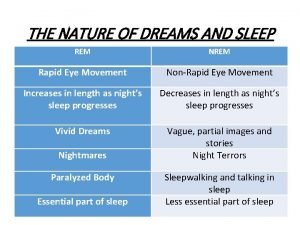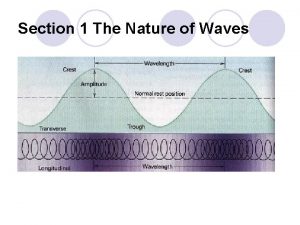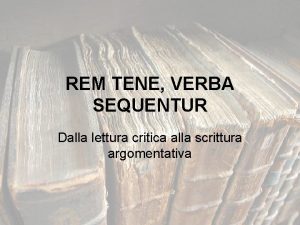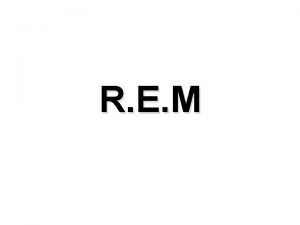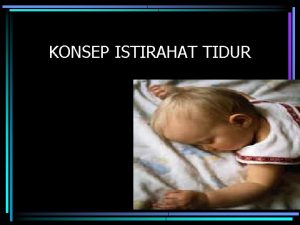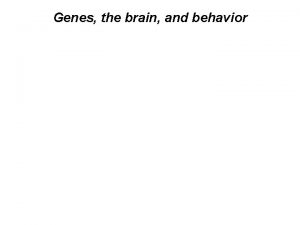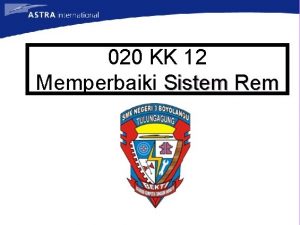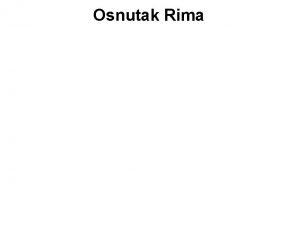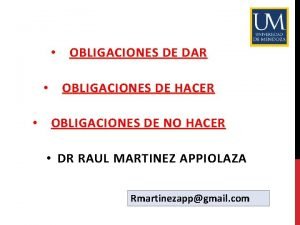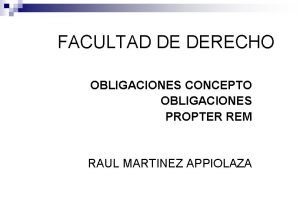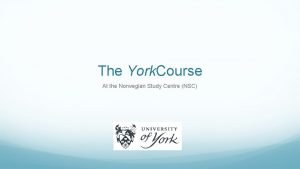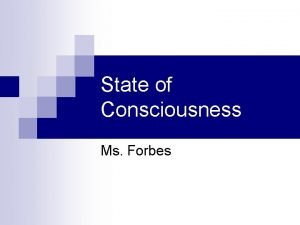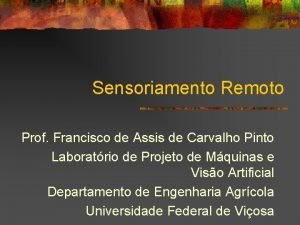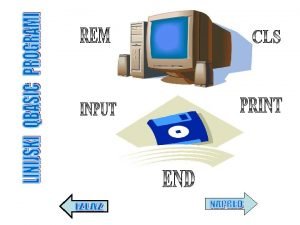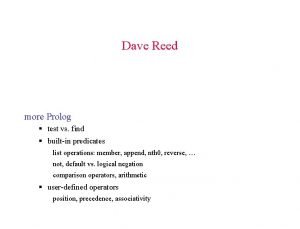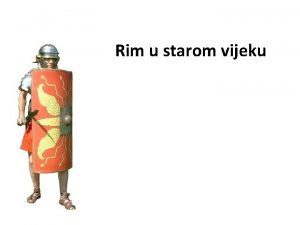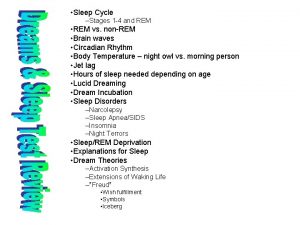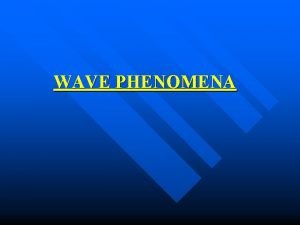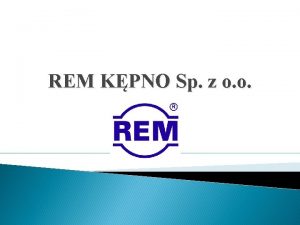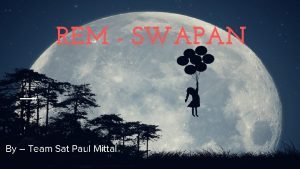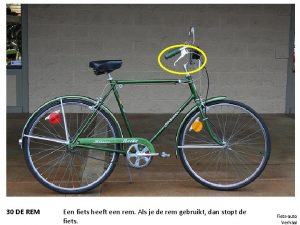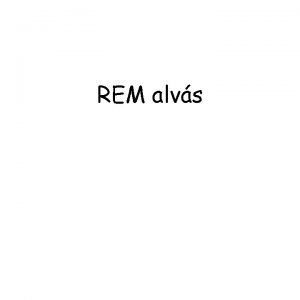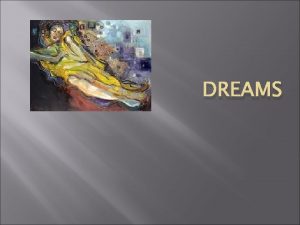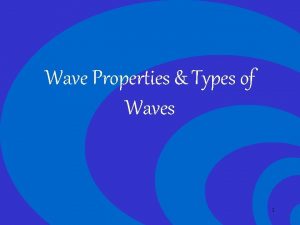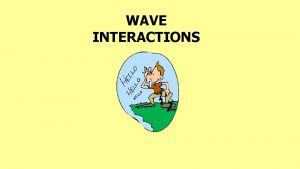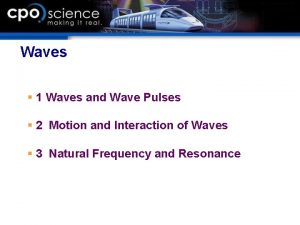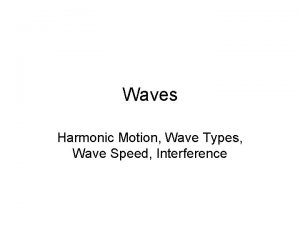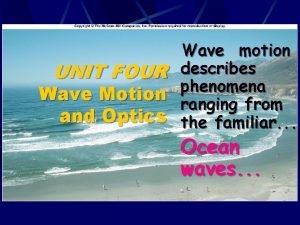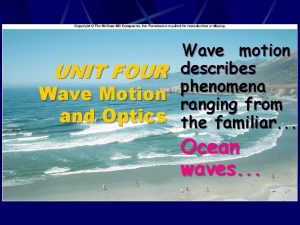Waves and Wave Motion Waves Wave Motion rem

















































- Slides: 49

Waves and Wave Motion Waves, Wave Motion rem to show clips of doppler effect, interference, reflection, refraction and diffraction.

Waves and Wave Motion In this section you will be able to: Explain – frequency, wavelength, amplitude, transverse waves, longitudinal waves, stationary wave, antinode and node. Define – reflection, refraction, diffraction, constructive interference, destructive interference, polarisation and the doppler effect. Know c = f λ and f' = fc c±u and use to solve problems

Waves and Wave Motion Describe – experiments to show reflection, refraction, diffraction, interference, polarision and the doppler effect. List – five everyday examples of waves. Know – uses of the doppler effect and explain the red shift of stars.

Waves can be mechanical or electromagnetic. Mechanical waves must have a substance to travel through called a medium. Examples are water waves, wave on a rope, waves on a spring, sound and ultra sonic waves. Something must vibrate. Electromagnetic waves can travel in a vacuum. No medium is needed and they travel at 3. 0 x 108. Examples are light, I. R. , U. V. , micro-waves, x-rays and gamma rays.

Travelling Waves WAVES THAT MOVE FROM ONE PLACE TO ANOTHER. Waves on rope or on a slinky. Waves on water, can be caused by wind or throwing a stone into water. Compression waves on a spring – use a slinky by holding a number of coils together let go and you get alternate compressions and rarefractions.

Waves Transfer energy through matter or space Remember there is no overall net movement of the medium only a disturbance as it passes. A Travelling mechanical Wave = a disturbance carrying energy through a medium without any net movement of that medium.

Waves May be longitudinal e. g. sound Or transverse e. g. Light , water

Wave Terms Crest = top of a wave. Trough = bottom of a wave. One cycle (oscillation) = one crest and one trough. Amplitude = maximum disturbance of the medium from rest position (m) Wavelength (λ) = the distance from any one point on a cycle to the corresponding point on the next cycle. (m) For longitudinal waves One cycle consists of one compression and one rarefraction.

Wave Terms Frequency – number of cycle (wavelengths) passing any point per second. (Hz) Velocity of a wave = frequency x wavelength (c = fλ)

Properties of waves Period is defined as the time taken for a point in the vibration to complete one oscillation (T / s). consequently © TPS

Waves travel through a medium such as: water air solids

Wave phenomena Waves have certain properties: • They usually travel in straight lines as they pass from one point to another 12 © TPS 2010

Wave phenomena Waves have certain properties: • They spread out from their point of origin like the ripples on a pond Some waves can spread out in all three directions. 13 © TPS 2010

Wave phenomena Waves have certain properties: • They reflect from certain surfaces • They obey the laws of reflection which means that the angle of incidence is equal to the angle of reflection Angle of incidence Angle of reflection Normal Note that the normal, incident ray and reflected ray all lie in the same flat plane. 14 © TPS 2010

Wave Properties reflection refraction interference

Wave phenomena Optical fibres rely upon both reflection and refraction. It is possible to code huge amounts of information into digital light signals. 16 © TPS 2010

Wave phenomena Optical fibres present engineers with superb opportunities. As a result, small optical fibres can replace huge quantities of copper cables which obviously saves money and makes it possible 17 to transmit much larger amounts of data. © TPS 2010

Wave phenomena Waves have certain properties: • They diffract When you allow waves to pass through a small aperture (hole), they tend to spread out. This is called diffraction. Ripples look like this when they diffract: spreading out in all directions. 18 © TPS 2010

Wave Properties Diffraction: the bending of a wave around the edge of a barrier.

Reflection, refraction, diffraction and interference

Waves Changing Speed When waves go from one medium into another medium they usually change speed. The freqency does not change so since c = f λ then λ must increase if the wave speeds up and λ must decrease of the wave slows down. It is that causes refraction if wave enters the new medium at an angle other than 90 o. Refraction is the changing of the direction of waves as it moves from one medium to another medium

Coherent Waves and Interference Coherent sources are those sources of waves which emit continous waves of same wavelength , same frequency and are in same phase or have constant phase difference Light from a laser is an example of a coherent source.

Wave phenomena Interference Consider a wave as illustrated by the displacements shown in blue below. 23 © TPS 2010

Wave phenomena Interference If we now add a second wave, as illustrated in green, the waves will interfere. The principle of superposition can be used to work out the resultant displacement. 24 © TPS 2010

Wave phenomena Interference The line in red shows the resultant wave which is simply calculated by the addition of the displacements of the individual waves. 25 © TPS 2010

Interference Constructive Interference occurs when two waves meet and they amplify each other giving a greater amplitude than the individual waves. Destructive interference occurs when two waves meet giving a wave of less amplitude of the individual waves.

Sound waves Longitudinal waves Need a medium to travel through Cannot travel through a vacuum Speed of sound is 340 m/s in air

Water waves have transverse and longitudinal characteristics. Energy is transferred, but the particles stay essentially in the same place

Polarisation Happens for transverse waves only. For transverse waves vibrations in all directions at right angles to the direction of wave motion. When tranverse waves travel through a vertical slit it vibrates in the up and down direction only the wave is said to be plane polarised

Wave phenomena Waves which have vibrations just in one plane are said to be polarised. A polarised wave contains waves which have their directions of vibration aligned. 30 © TPS 2010

Wave phenomena Waves whose vibrations are not aligned are not polarised. Waves often become polarised on reflection. 31 © TPS 2010

Wave phenomena Waves whose vibrations are not aligned are not polarised. Waves often become polarised on reflection. 32 © TPS 2010

Stationary Waves When waves on a rope hits a fixed end, it reflects and is inverted. This reflected waves then combine with oncoming incident waves. At certain frequencies the resulting superposition yields a stationary wave, in which some points on the rope called nodes never move at all, and other points called antinodes have an amplitude twice as big as the original wave. A rope of given length can support standing waves of many different frequencies, called harmonics, which are named based on the number of antinodes.

Stationary Waves Stationary waves are produced by adding together of two traveling waves of equal amplitude and frequency, travelling with the same speed in opposite directions. It is a pattern due to interference Stationary waves occur by resonance only at the natural frequencies of vibration of a medium.

Properties of a stationary wave (1) Stationary waves have nodes where there is no displacement at any time. In between the nodes are positions called antinodes, where the displacement has maximum amplitude. Nodes λ Antinodes

Properties of a stationary wave (2) All particles between two adjacent nodes are in phase. The waveform in a stationary wave does not move through medium; energy is not carried away from the source. The amplitude of a stationary wave varies from zero at a node to maximum at an antinode, and depends on position along the wave.

Production of Stationary Waves http: //www 2. biglobe. ne. jp/~norimari/science/Java. Ed/e-wave 5. html A stationary wave would be set up by causing the string to oscillate rapidly at a particular frequency. If the signal frequency is increased further, overtone patterns appear.

Resonant Frequencies of a Vibrating String From the experiment, we find that There is a number of resonant frequencies vibrating string, in a The lowest resonant frequency is called the fundamental frequency (1 st harmonic), The other frequencies are called overtones (2 nd harmonic, 3 rd harmonic etc. ), Each of the overtones has a frequency which is a whole-number multiple of the frequency of the fundamental.

Doppler effect Change in frequency and pitch of a sound. Due to the motion of either the sound source or the observer. Listen! Show video clip on doppler effect

Doppler effect of sound

Doppler effect in light As stars move away from earth, there is a shift in the light towards the red end of the spectrum.


Doppler Equation f. L = fc c u f L = frequency as heard by a listener f = frequency produced by the source c = speed of sound in the medium u = speed of the source This equation takes into account the speed of the source of the sound, as well as the listener’s speed, relative to the air (or whatever the medium happens to be). The only tricky part is the signs. First decide whether the motion will make the observed frequency higher or lower. (If the source is moving toward the listener, this will increase f L and it will c-u, but if the listener is moving away from the source, this will decrease f L and it will be c+u)

Doppler Effect for Sound Waves As a moving source of sound approachs if frequency appears to increase and when moving away the frequency decreases. Examples include: A passing ambulance A passing racing car A train passing sounding a horn It can be demonstrated by whirling an electronic buzzer in a circle.

Doppler Effect for Electromagnetic Waves As a moving source of sound approachs if frequency appears to increase and when moving away the frequency decreases. This applies to electromatic waves as well. Examples include: A star moving away from us has a redshift (f down up ) A star moving towards us has a blueshift (f up down ) The doppler effect occurs for microwaves too which is used by the Gardaí for speed traps.

Doppler Problem 1 Mr. Magoo is passed by a police car going at 30 ms-1 If the siren emits a note of frequency 1 k. Hz what is the frequency heard by Mr Magoo when (i) garda car approaches him, (ii) the garda car moves away from him. Assume the speed of sound 336 m/s. 1000 is x 343 Car fapproaching L = 343 - 30 fc ' ' = 1096 fc Hz f = c u c-u f' = 30 ms-1 (1000)(336)= 1000 x 1098 343 Hz f L = 336 -30 343 + 30 Car moving away f' == 920 fc Hz c+u f' = (1000)(336)= 918 Hz 336+30

Doppler Problem 2 A train travelling at a constant speed passes through a station. To a person standing on the platform the note emitted from the train horn changes from 1216 Hz to 960 Hz. What was the velocity of the train and actual frequency of the horn? = moving away: For the approaching train: For thef Ltrain ' f = fc c-u 1216 = 340 f 340 -u (1216)(340 -u)= 340 f ' f = fc c+u 960 = 340 f 340+u (960)(340+u)= 340 f Now (1216)(340 -u)=(960)(340+u) 413440 – 1216 u = 326400 + 960 u u = 40 m/s (1216)(340 -40)= 340 f f = 1072. 9 Hz

Doppler Problem 3 A whistle emitting a note of 2 k. Hz is whirled in a horizontal circle at an angular velocity of 6 rad/s. If the highest not heard is 2100 Hz. Find (i) the radius of the circle and (ii) the lowest note heard by the observer. Highest note when source is moving f L = towards the observer at A f' = fc c-u 2100 = (2000)(340) 340 – u = (2000)(340)/2100 u = 340 – 323. 8 u = 16. 19 m/s Now v = r therefore 16. 19 = r 6 r = 0. 86 m B r To observer A

Doppler Problem 3 cont. The lowest frequency occurs when the source is moving away from the observer at 16. 19 m/s at B. ' f = fc c+u f' = (2000)(340) 340 + 16. 19 f' = 1909. 1 Hz f. L = B r To observer A
 Rem dreams
Rem dreams Standar ketebalan kampas rem tromol mobil
Standar ketebalan kampas rem tromol mobil Compare and contrast p waves and s waves using venn diagram
Compare and contrast p waves and s waves using venn diagram Difference between electromagnetic and mechanical waves
Difference between electromagnetic and mechanical waves Example mechanical waves
Example mechanical waves Difference between electromagnetic and mechanical waves
Difference between electromagnetic and mechanical waves Short wave vs long wave radiation
Short wave vs long wave radiation Difference between matter waves and electromagnetic waves
Difference between matter waves and electromagnetic waves Mechanical and electromagnetic waves similarities
Mechanical and electromagnetic waves similarities Seismic waves
Seismic waves Electromagnetic and mechanical waves
Electromagnetic and mechanical waves The difference between constructive and destructive waves
The difference between constructive and destructive waves Ability of two or more waves to combine and form a new wave
Ability of two or more waves to combine and form a new wave Sound is a transverse wave true or false
Sound is a transverse wave true or false Characteristics of a longitudinal wave
Characteristics of a longitudinal wave Sound is a longitudinal wave
Sound is a longitudinal wave Mechanical waves vs electromagnetic waves
Mechanical waves vs electromagnetic waves Is a seismic wave mechanical or electromagnetic
Is a seismic wave mechanical or electromagnetic Remlab
Remlab Rem tene verba sequentur analisi
Rem tene verba sequentur analisi Rem blok tunggal
Rem blok tunggal Postanowienie o umorzeniu dochodzenia
Postanowienie o umorzeniu dochodzenia Tidur normal
Tidur normal Difference between sievert and roentgen
Difference between sievert and roentgen Phenylketonuria (pku)
Phenylketonuria (pku) His cognitis rebus caesar rem frumentariam
His cognitis rebus caesar rem frumentariam Prinsip kerja rem tromol
Prinsip kerja rem tromol Romul i rem legenda
Romul i rem legenda Obligaciones propter rem ejemplos
Obligaciones propter rem ejemplos Res declinazione
Res declinazione Obbligho
Obbligho Religion rem
Religion rem An đéc xen
An đéc xen Irina
Irina Adults spend about ______% of their sleep in rem sleep.
Adults spend about ______% of their sleep in rem sleep. Universalia post rem
Universalia post rem Rem
Rem Naredba rem
Naredba rem Actio publiciana in rem
Actio publiciana in rem Rem fire systems
Rem fire systems Define rem
Define rem Varica rem narravit
Varica rem narravit Chapter 7 altered states of consciousness
Chapter 7 altered states of consciousness Modestus tam miser erat ut rem diutius ferre non posset.
Modestus tam miser erat ut rem diutius ferre non posset. Oktavijan
Oktavijan Frisk rule35
Frisk rule35 Dasar teori hukum pascal
Dasar teori hukum pascal Difference between full wave and half wave rectifier
Difference between full wave and half wave rectifier Transverse and longitudnal waves
Transverse and longitudnal waves Full wave rectifier example
Full wave rectifier example
